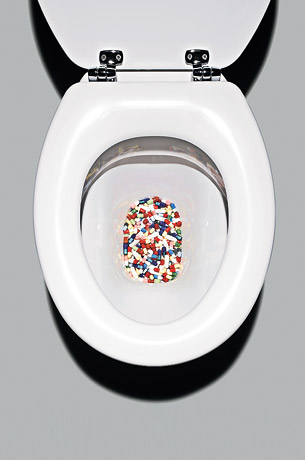
The planet may still be paying for the cold you had last winter. If it was a bad one, you probably took medicine. Maybe you rinsed the little dosing cup in the sink every time you used it. Maybe you finished the bottle and threw it in the trash. What you surely did several times a day was go to the bathroom — perhaps more than usual if you were taking care to drink plenty of liquids — and some of that medicine passed straight through you. What all this means is that while you were taking your cold medicine, so was your local water supply.
The planet is also paying for your dad's hypertension, your aunt's high cholesterol and your colleague's throat infection, all of which were treated with drugs whose chemical residue then leaked into sewers or was leached into landfills and water tables. All told, there are about 3,000 prescription pharmaceuticals in use in the U.S. and thousands more over-the-counter drugs, not to mention creams and ointments we smear on and then shower off. "Between cosmetics, pharmaceuticals and other sources," says John Spatz, commissioner of Chicago's department of water management, "there are 80,000 potential combinations of chemicals." It's impossible to keep our drinking supply safe from a gusher like that. Wastewater from homes gets treated at sewage plants, but it's never possible to remove every trace of drugs. What's more, sewage pipes break, septic tanks overflow, and in some parts of the U.S. "straight-piping" — which sends untreated sewage flowing directly into surface water — is still practiced. One way or another, the drugs find their way back to us.
Pharmaceutical pollutants are worrisome for reasons beyond their mere numbers. They're also specifically designed to be reactive with human tissue. If they weren't, they'd be useless. In March, Lisa Jackson, administrator of the Environmental Protection Agency (EPA), announced that Washington is formulating new rules to regulate all contaminants in water, including drugs. The measures will include better enforcement of existing regulations, closer coordination with states and development of new water-treatment techniques. "We are identifying contaminants at a much faster pace than we are addressing them," she warned in an address to the Association of Metropolitan Water Agencies (AMWA) in which she announced the new policies.
In the 1970s, scientists began detecting pharmaceutical residue in waterways, but in an era when rivers were choking on industrial sludge, traces of drugs seemed a small matter. It would take until the 1990s for that view to change. That was when pharmaceutical estrogens, principally from birth control pills, began showing up in the water too, leading to male fish with androgynous sex organs. Scarily, it did not take much estrogen to affect the fish — just 5 or 6 nanograms, or billionths of a gram, per liter of lake water.